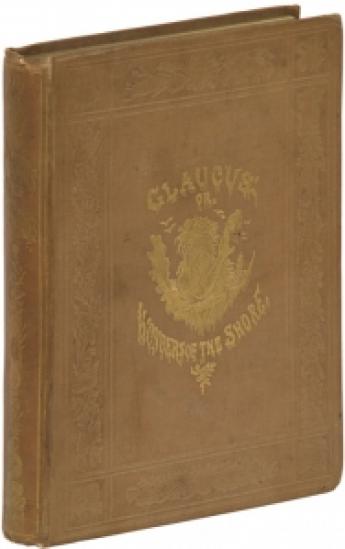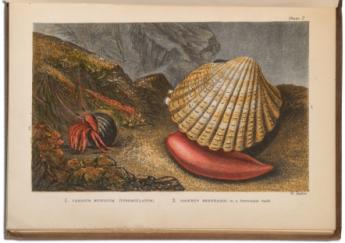Tip Antiquarian Booksellers' Association of America Between the Covers Rare Books, Inc.
The Wonders of the Shore in Color

By Ken Giese
Long before Darwin’s Origin was published in 1859 there was in Victorian society a strong popular interest in natural history. Not only did the microscope reveal previously hidden wonders, exposing for the first time the sexual life of plants, but advances in printing technology made it possible to reproduce and disseminate such images – in color – among the new and rapidly growing middle and working class populations. An excellent example of this historically unique intersection between science, technology and religion just appeared on my desk: the 1855 edition of Rev. Charles Kingsley’s Glaucus, or the Wonders of the Shore.
Kingsley, an impulsive country parson and Christian socialist, author of Westward Ho! and The Water-Babies, is best known for calling John Henry Newman a liar and a knave “to his face.” As I have always been grateful to Kingsley for provoking Newman to write his great autobiographical defense of Catholicism, I decided to take a closer look at this book.
It was in this work that Kingsley coined the word Pteridomonia, or Fern Madness, in reference to the daughters of respectable fathers of all classes who are “collecting and buying ferns…and wrangling over unpronounceable names of species (which seem to be different in each new Fern-book that they buy…).” Indeed, also in 1855 the Society for Promoting Christian Knowledge published, The ferns of Great Britain and Allies the Club-mosses, Pepperworts, and horsetails. Clearly both Kinglsey and the Society viewed this Victorian craze for collecting ferns as a wholesome activity to be encouraged; and expanded to include all aspects of natural history, thus serving both as a means of keeping families and friends engaged in industrious pursuits while on vacation, and united in awe of the wondrous works of God. What unites both books and ensured their success are the color plates, which were engraved and printed by William Dickes using a newly patented “Baxter Process.”
These color plates are typically misidentified as hand-colored lithographs or chromolithographs. By the 1850s lithography was the cheapest and fastest way to achieve commercially viable color prints, but a close inspection of the plates in Glaucus reveals etching, aquatint engraving, and wood engraving, i.e., a combination of intaglio and relief printing. The best color prints were achieved by printing from multiple wood blocks engraved on the end grain of a hard wood like box. As this was a labor intensive process and a less versatile medium, George Baxter developed his more commercially viable method of combining intaglio and relief processes – and sometimes lithography (a planographic process) – which allowed for the artistic effects and versatility of finely inked lines and etched tones in metal to be had in combination with colors printed from wood.
Baxter described his process as “printed in oil colours,” and a few modern museum curators have indeed mistaken a Baxter print for an oil painting! The process involved the successive printing, one color at a time, upon an initial impression taken from a key block of the design. The key block was typically a steel plate, and the successive impressions of colors were taken from up to twenty blocks of wood. It was this overlaying or building up of color upon an etched and engraved design in black that gives the overall impression of an oil painting. Of crucial importance in obtaining this effect was the skill of the printer in creating the color inks used and in maintaining an exact registration on the sheet during the printing of each impression. Baxter devised a special arrangement of registration points on the tympan of the platen press, and he patented the process from 1835 to 1854. William Dickes was one of only five English engravers and printers granted a license to utilize the Baxter process.
Pictured above are two common wonders from Glaucus: on the left a Common Hermit Crab (“Pagurus Bernhardi in a Periwinkle Shell”), and on the right a Red-Nosed Cockle (“Cardium Rusticum”). As this print is principally tonal, the key-design in black is mostly aquatinted, with etched lines used to outline the crab and the patterning on the cockle shell. The background aquatint grain is lightly etched and printed in black and blue, giving the illusion of three-dimensional depth in contrast to the deeply etched foreground aquatint grain giving the sea floor and rock built up in combinations of black, blue, brown, green and vermillion, with the dramatic three-dimensionality of the crab and cockle’s long foot and shell achieved almost entirely from wood engraved blocks giving a combination of the densest patches of the brightest colors ranging from brilliant crimson red to pale vermillion and creamy off-white.
This is fine craftsmanship by W. Dickes and Company. Dickes continued to make Baxter process prints after his license expired on through to the 1870s, when photographic processes began to displace the older mechanical processes. The older processes relied on an artist to draw and color the original design, a craftsman who engraved and made the original printing surfaces, and the printer who mixed the color inks and made the complex series of multiple impressions. A genius like William Blake did this all himself. We know that Dickes was a skilled wood engraver and printer, but such complex work requiring long press runs required many skilled hands.
Prints made by Baxter himself are today highly sought after by enthusiasts. Although they can be easily identified by his phrase, “Printed in Oil colours by G. Baxter, Patentee,” it is typically no longer present on the surviving prints. Among the licensee’s who made Baxtertype prints, the best are those by J. M. Kronheim, Le Blond & Co. and W. Dickes & Co.
It should be noted that of the twelve splendid plates in Glaucus, three depicting schematic drawings of the smaller wonders (plants and animals) were drawn by “G. B. Sowerby & C. K.” In addition to engraving and printing all of the plates, it is likely that Dickes made the designs of the nine plates depicting the larger wonders in the wild. Clearly the artistry and craftsmanship of the plates is all Dickes & Co., Kingsley having provided a few small sketches after Sowerby. While it is easy to misidentify a Baxter and Baxterype print, I was appalled to see an online commercial gallery identify Kingsley as the painter of the print shown above! – For just $238.98 (As seen on TV!) you can purchase at 1st-art-gallery.com a “handmade oil painting reproduction of Cardum Rusticum and Pagurus Bernhardi in a Periwinkle Shell, a painting by Charles Kingsley…Why settle for a paper print when you can own a real handmade oil painting on canvas? Order your handmade reproduction of Cardum Rusticum and Pagurus Bernhardi in a Periwinkle Shell today!” Or you can just buy the original.
The article is published in the Between the Covers Blog, it is presented here by permission of the author. Thank you very much.

